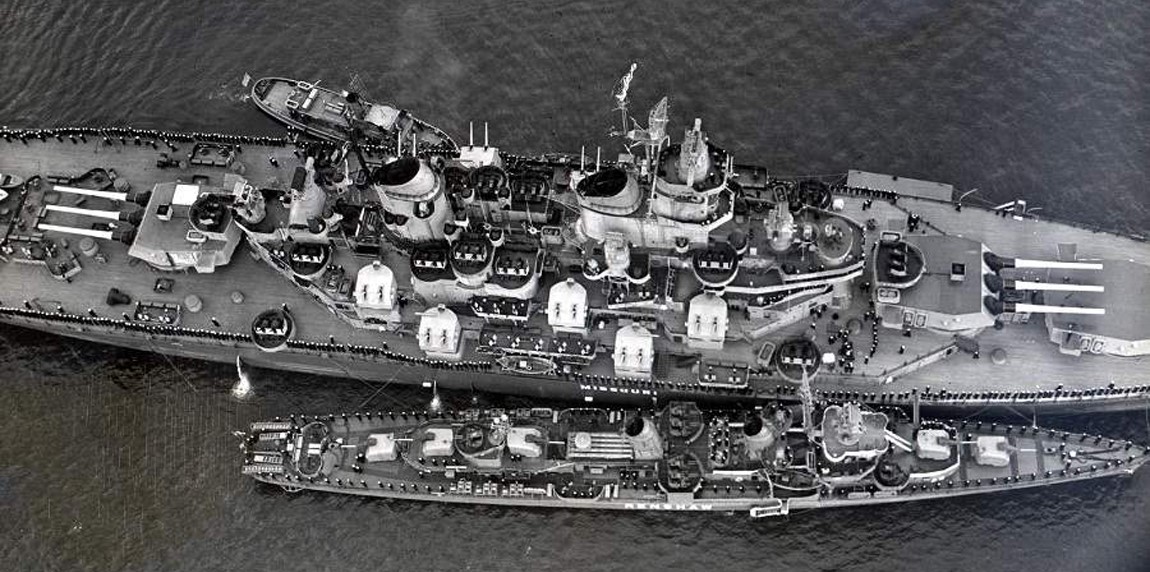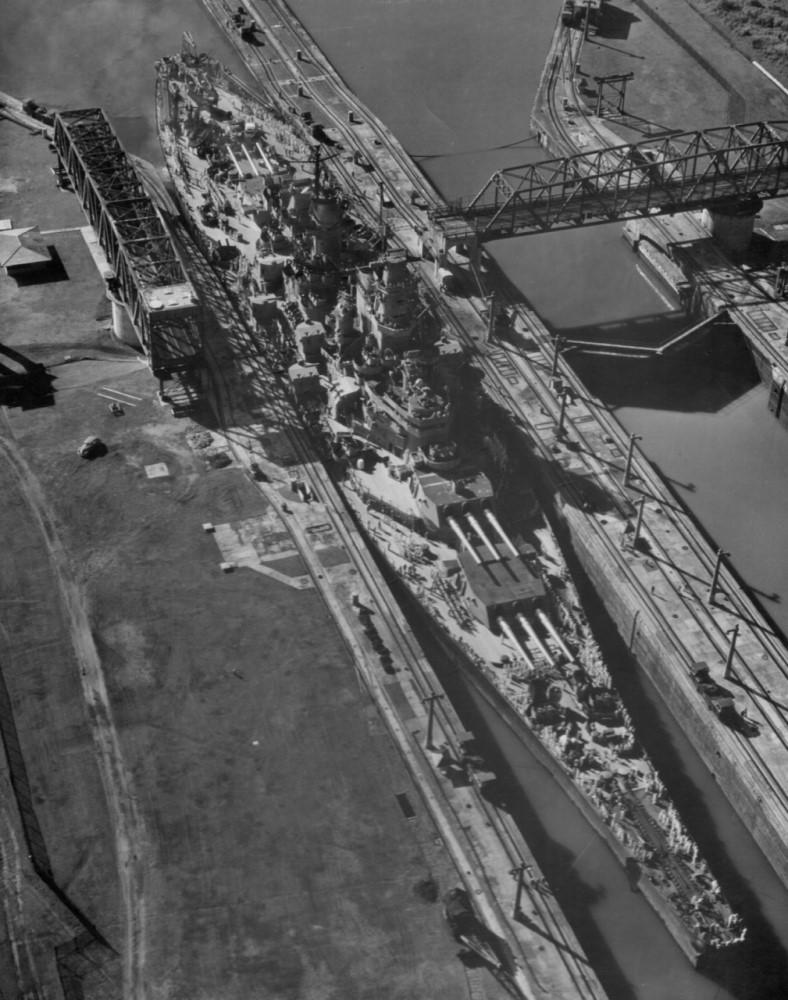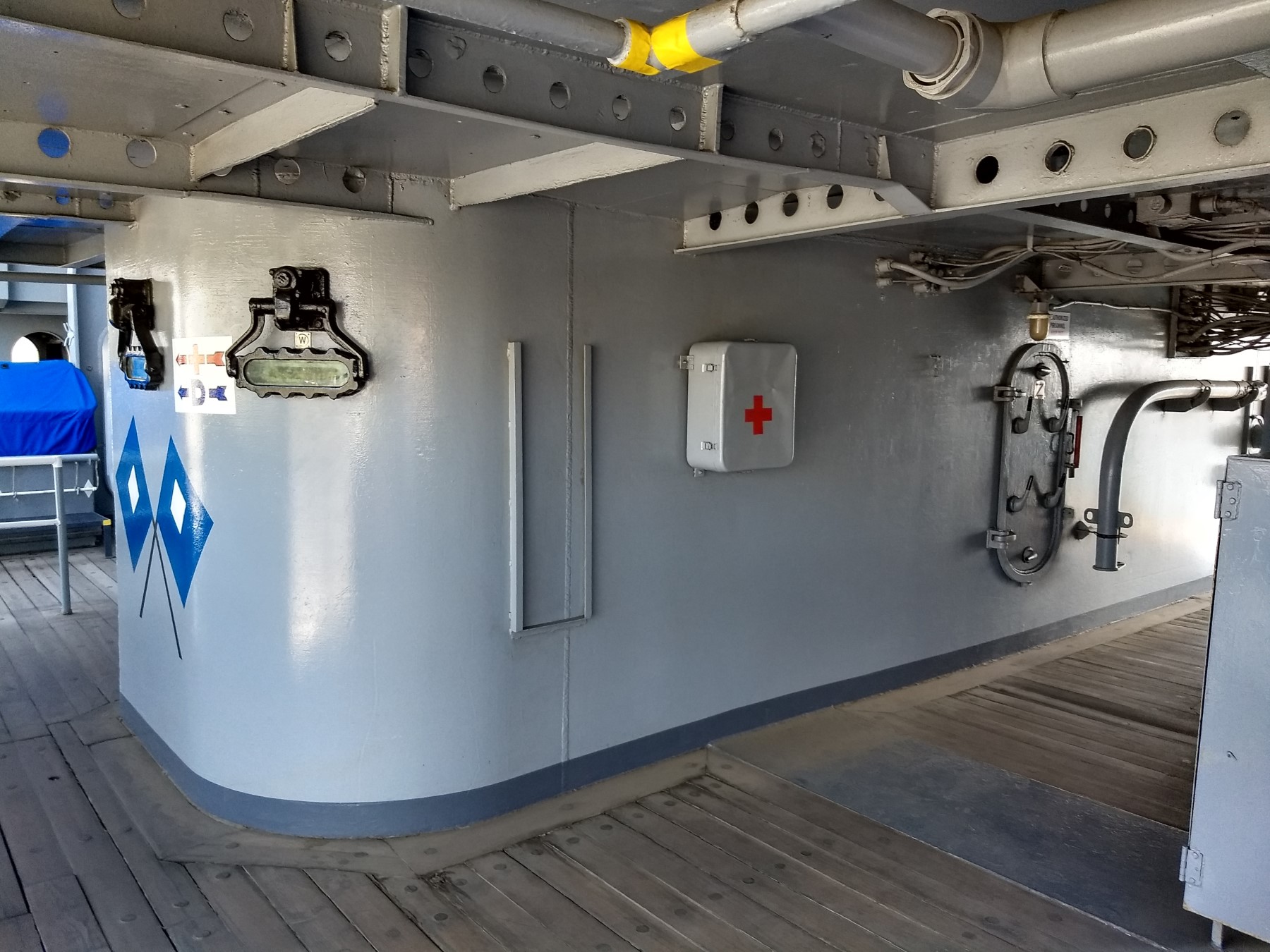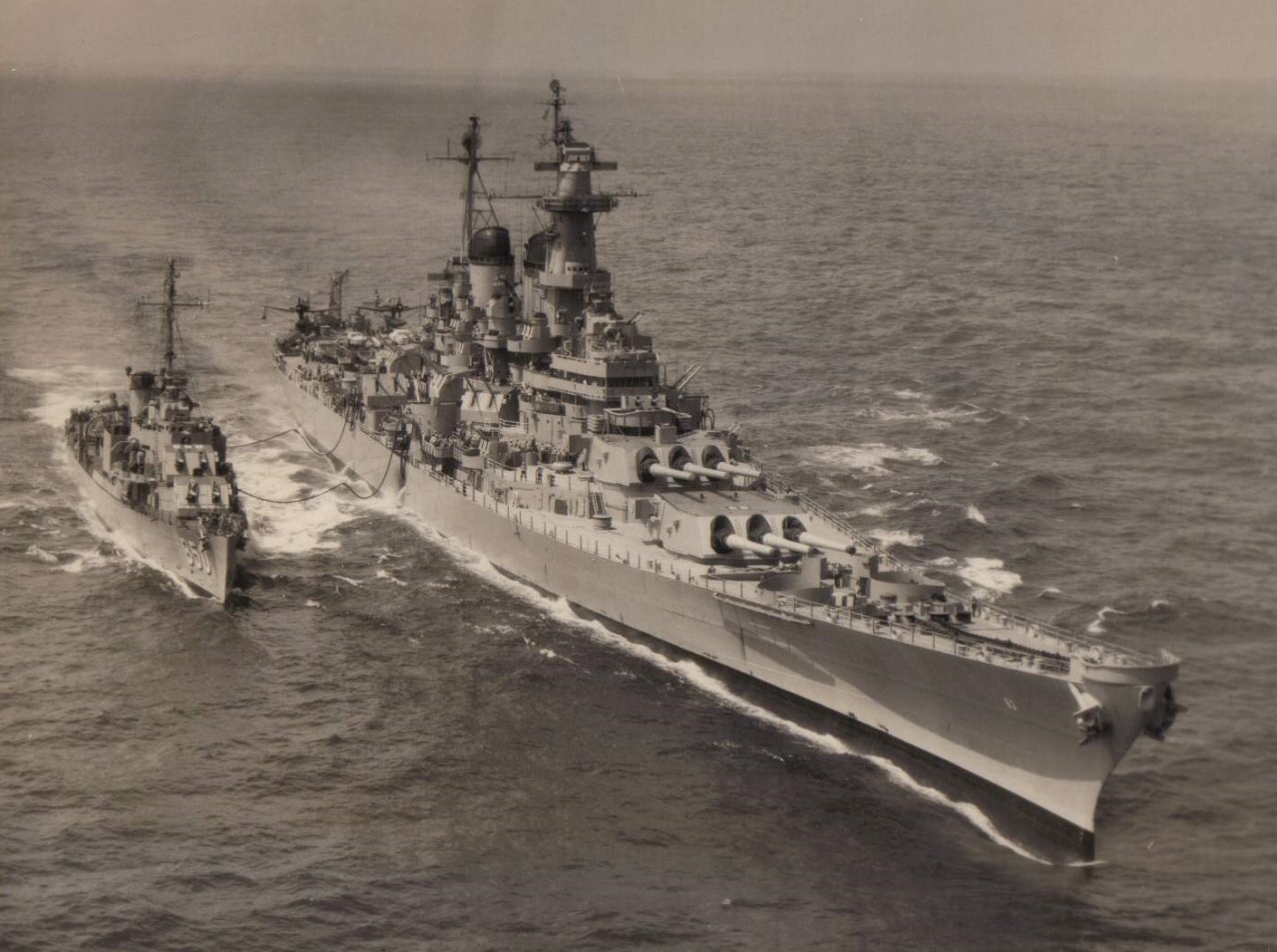The Soviet Union was not alone in looking at building battleships after WWII. The US and Britain both also took looks of varying seriousness during and after the war, drawing on their combat experience to fix the problems of the wartime battleships. The common thread throughout these designs would be an increased focus on the threat from airplanes instead of other battleships.

The final Montana design
Formal US design studies ended in mid-1942, and looked at variations on the basic Montana class, with thicker decks and better AA arrangements. The need for protective decks was seen as particularly acute early in the war, before it became obvious how difficult it was to hit a moving target from high altitude, and the Bureau of Ships looked at reducing the belt to Iowa thickness in exchange for increasing the total deck thickness from 9.24" (equivalent to a single thickness of 7.3" when the different layers were taken into account) to 10.4" (equivalent to 8.3"). This new deck would be enough to keep the US 14" AP bomb out if dropped from anywhere below 19,000'. Other sketches were prepared that accepted a reduction in speed in exchange for an increased AA armament, with better sky arcs than that planned in the existing sketches. By the standards of 1944, even the increased AA armament seemed hilariously lacking, with 16 5"/54s, eight twin Bofors and 24 Oerlikons. One all-machine gun design was even considered, apparently a result of fleet dissatisfaction with heavy AA fire control early in the war, although no details seem to have survived.

Missouri shows most of her AA guns, although two Bofors are out of sight both fore and aft, along with Oerlikons
The main reason that the secondary armament on those earlier sketches seems so minimal by later standards is that the battery eventually fitted to Iowa - 19 quad Bofors and 60 Oerlikon mounts - came at a significant cost in other characteristics, which would not have been considered acceptable in a clean-sheet design. All but a handful were located in areas where they restricted the arcs of the main guns, were vulnerable to damage from blast or sea, restricted the view of important ship-control stations or had limited arcs of fire. This was accepted during wartime, but the air threat wasn't going to go away after the war, and so most of the 40mm mounts were retained into the 1950s.

The suitable base for postwar battleships
Postwar, limited budgets made it clear that battleship construction wasn't going to resume any time soon, and so BuShips spent its time on other ship types. As a result, the last glimpse we have of the future of the American battleship comes from an unofficial source, a board convened by Admiral Nimitz two weeks after the Japanese surrender and tasked with forwarding the recommendations of the Pacific Fleet for the future US Navy, including its battleships. The report starts by affirming the importance of the battleship in the postwar fleet, and suggests that the Iowa class is the ideal basis for any new battleships, thanks to its ability to keep up with the carriers and general soundness as proven by war experience.

Missouri, demonstrating why she and her sisters weren't beamier
That isn't to say they weren't able to think of improvements, as the vast majority of the report is about the changes that should be made to an Iowa successor, if one was to be built. The board suggested that the ship's great draft was an issue, and that a successor should be shallower and beamier, which would improve stability and give more space topside. Seaworthiness was judged satisfactory, except that the ships were quite wet aft of Turret II. This was the result of the rapid transition from the narrow bow to the broad section around Turret I, and it was suggested that a less weight-critical postwar design could make the transition more gradual. The section on main armament is relatively conservative, as there were suggestions floating around to remove some or all of the turrets in favor of more AA firepower. The report considers these premature, although it does recommend investigating designs with only two turrets, either triple or quadruple, and using the savings in space and weight for a better AA battery. This would make even more sense if one of the other recommendations, for a much faster loading mechanism for the main guns, was adopted. The other major proposal for the main armament was to fit each turret with its own radar and generator, allowing it to fight independently in the event of damage. The arrangement for handling ammunition also came in for criticism. Parbuckling, sliding shells on their bases by use of winches, was considered too slow to sustain the hoped-for rates of fire, while the method of striking rounds below during replenishment was entirely too slow, and they suggested replacing it with a system where the shells would be loaded into the turret through a hatch in the back and sent down the hoists to the projectile flats.

Cruiser Los Angeles with centerline 5" guns
The big issue with the AA armament, heavy or light, was less quality and more arrangement. The light AA guns just needed to be moved higher in the ship to keep them out of the weather and blast, and given good arcs, but the 5" guns were going to be trickier. The existing layout, with turrets in two rows on either side of the ship, meant that the 5" guns weren't particularly effective when firing directly forward or aft. This could be rectified by modifying the superstructure so the existing side mounts had better arcs, or by fitting 5" turrets on the centerline, firing over the main battery and giving a full arc across the bow or stern. Centerline 5" mounts were fitted to most American cruisers, but the possibility seems to have been ignored in battleships, probably because of centerline space constraints, and because they would have required the heavy conning tower to be raised, with serious consequences for weight and stability. This was solved in the recommendations by a suggestion that the need for the heavy conning tower should be reexamined. Several of the older battleships had lost theirs during refits, and the only time when one had come in handy was aboard South Dakota at Guadalcanal.

The signal shelter aboard Iowa
Nor was the conning tower the only change desired for the superstructure. The signal shelter aft of the flag bridge was to be deleted. Improvements in radio meant that there was no need for signalmen to hoist flags, or for a protected space for them. The weight, high up in the ship, could be used for other purposes, such as providing protected positions for the crew in case of strafing or atomic attack. But the harshest criticism was reserved for the ship-control arrangements. The ships had originally been designed to be operated from the conning tower at all times. In practice, this hadn't worked well due to lack of space, and the Iowas were refitted with pilothouses around the conning tower. These were cramped, and the view was not particularly good in confined waters. A secondary conning position had been added high up on the foremast early in the ship's careers, to allow the Captain to view the radars when waveguide limitations meant that the radar consoles had to be close to the antennas. This was now the XO's battle station, but it was too close to the bridge for comfort. A complete redesign would be needed, with attention given to, among other things, space for the voice radio team to be located near the bridge. Not near the bridge was the CIC, which would stay inside the armored box.

Iowa early in her career, showing the exposed conning tower and secondary conning position halfway up the fire-control tower
The rest of the recommendations were fairly minor. The board was in favor of keeping airplanes, but they suggested replacing the rotating catapult with a flush-deck model, presumably fixed athwartship. Less satisfactory were the crew quarters, which had been badly cramped by the extra personnel needed to man the added AA guns and support the Admiral's staff. Particularly bad were the CPO's quarters, which were right aft, where vibration and heat made them very uncomfortable. Air conditioning, uncommon at the time, had been required to make them livable. Lastly, the refueling rig should be relocated, as the ship's bow wave tended to make it hard to hold position.

Missouri refuels destroyer Joseph P Kennedy
Obviously, all of this came to naught. In the years immediately after the war, the US faced no real threat at sea, and there was no need to build new battleships. Even the existing ones were decommissioned and placed in reserve, save one kept in service by the President's whim. But it's interesting to see what sort of lessons the USN took from battleship operations during the war. But the British took things quite a bit further, and we'll take a look at their plans next time.

Comments
Statements like this always boggle the mind, "it's good enough for war, but not for peace" is madness. It's one thing to say that we're not going to include the guns in peacetime to keep manning down, then add them in war. It's entirely another to say "sure we need this much AA if anyone is shooting at us, but we're going to leave it out because it's annoying and ugly".
@Cassander
I don't think that's what it's saying?
I think it's trying to say "due to wartime exigencies, they were willing to accept tradeoffs in visibility and arcs of fire because of the threat posed by planes, but with the time and extra engineering options afforded by peacetime, they wanted a design without those tradeoffs." (i.e. they wanted AA, but didn't want to design in limitations on arcs of fire to the main guns)
Like, adding armor to the HMMWV is/was an expedient solution to IEDs and small arms fire, but the cleansheet solution is not to make add-on armor permanent (with all of the limitations that imposes), but to create a more streamlined solution that incorporates the armor from the beginning.
Oh, 16" guns with an automatic loader similar to the one used with the 8"/55 RF Mark 16...
Would it have worked, or the shells and the charges were too heavy?
It sounds like there's a matter of timing in there as well. The comparison is drawn between the mid-1942 sketches for Montana and the state of the Iowa when that ship went to war in 1944; but what was the planned light and medium AA fit for Iowa circa mid-1942? Certainly much less than she eventually commissioned with, and perhaps still as low as the 4 quad 1.1" plus a few .50 MGs her original plans called for?
@cassander
RedRover and Philistine are both right on this. In 1942, they hadn't reached later heights of AA armament, but there were also a lot of limitations to what they did. Acceptable when the alternative is the ship being sunk, but good navies tend to have design standards precisely to give them the margin for things like a massive AA battery when they need it.
@Emilio
It would have been very difficult. Remember that weight scales with the cube of bore size, so you're looking at having to move 8x the mass of the 8" automatic gun. I don't see any way you could do it with a bag gun, but now you're driving up the size and weight of the powder casings a lot, too. I suspect that 8" was about as far as you could push that tech practically, just because the mechanisms start to get way too big. And the Des Moines were really big ships for cruisers to accommodate their guns, so you're looking at an insane battleship.
right, but ship you're designing is facing the same trouble. If it was agreed that the 1942 level of AA was needed, then the correct response is to design ships with that level of AA, or at least provision for it.
It did broadly correspond to the 1942 levels of planned AA armament, keeping in mind that armament was evolving rapidly during WWII. A quick check of Dulin & Garzke for the SoDaks shows 8 50 cal, 7 1.1" and 16 20mm in March, switching to 5 1.1", 36+ 20mm and 16 40mm barrels (probably four quads, but could be some twins) in September. I believe a twin Bofors was broadly equivalent to a quad 1.1", so the 8 twin Bofors is close to the March armament. By February of 1943, they had gotten rid of the 1.1" and gone to 35 20mm and 17 quad 40s. (At least these are official batteries. I could probably dig the actuals out of Friedman or something, but I can't be bothered.
"The report starts by affirming the importance of the battleship in the postwar fleet"
How f*cking stupid! Did these people not remember the war that just ended!
Yes, one can find a use for battleships in 1950 .. but don't. There are 17 zillion better ways to spend military budget, and this was obvious by 1944.
(If you feel a reflex need to defend battleships in 1950, start by saying what mission they would do better at than the same money spent on the right ship. And if the mission is jack-of-all-trades, please note the aircraft carrier commander with a smile and a history book.)
Kit, you will note that the phrase you quoted was a link, which is where I make the case for the importance of the battleship in 1950 at some length. In reality, yes, the postwar budget crunch and the lack of any serious naval opposition meant that the US and Britain mostly decommissioned their ships earlier than that, but the scope of the budget issues wasn't apparent to most for another few months, and this was a board of line officers that was supposed to talk about lessons learned from the Pacific War. Given their remit, what they said was entirely reasonable.
Was just wondering the other day why the Des Moines stuck with 3 triple turrets despite the higher rate of fire.
I guess two turrets fore and aft would halve your firepower directly forward? Would an all-forward arrangement work? (a 2/3rds Nelson? ;p)
What exactly are all the features on Iowa's mast in that pic? Is the fire control station the windowed box with antennas coming out the sides, and the secondary conn the box with vertical slats below it?
With you comment at the end about the Brits, I recommend Drachinifiel's video on the Lion Class Battleships. They went a bit nutty post-war.
@echo: The fire control station (main director) is right at the top with the short thick cross piece (rangefinder) and turns to face the target, the next level down is what the HNSA plans (of 1980s New Jersey, by which time its long thin cross piece seems to have been removed) call the air defense station, and yes the one below that is what they mark as secondary conn.
The secondary conn is the thing with the vertical slats. That's actually distinctive to Iowa, and a very useful identification aid in photos. muddywaters has provided photos of the director Below that is the air defense level, so called because spotters for air defense were placed there.
I don't remember the details on the Des Moines, but speculating wildly with no research at all, I think that they were intended to achieve a specific rate of fire, which set the number of guns. And if you have 3 turrets, then 2-A-1 is the most sensible approach.
@Jack
I have the books that I'm sure Drachinifiel based his video off of.
"Kit, you will note that the phrase you quoted was a link, which is where I make the case for the importance of the battleship in 1950 at some length."
I read the linked page. And it strongly shows that battleships were tough to sink by 1940's aircraft. But that's not the claim. The claim is that battleships were an efficient way to spend military money in 1950. And I don't know a single mission where 'battleship' is the most cost-effective way to solve the mission in 1950. Note that a ship who's design started in 1950 will be in service in 1980, and although in 1950 they don't know the future, that can see current trends in aircraft and missiles. They can also look back to WWII, where the war was decided by submarines, anti-submarines, and aircraft carriers.
I am not saying that a new battleship would have been a good way to spend the military's budget in 1950. I don't think there was anyone in 1950 who thought that (outside the Soviet Union, that is) and not very many in 1945. The report (which is literally the last official trace I know of of new-build American battleship design) was PacFlt saying "here are the lessons learned from the war", and they included recommendations for new ships of all types, not just battleships. The tone is definitely more "lessons learned" than "we should do this", particularly as it was done by naval officers and not naval architects. There is definite value in that. There was also value in asserting on behalf of PacFlt (and thus the carrier force) that the battleship wasn't completely useless, which was probably the popular view.
Kit:
But until aircraft had reached the point of being able to operate when the birds are grounded there are still missions that are best done by battleships.
Of course that was just an argument for keeping some in service, not building more given that it would be rare and they were obviously going to be obsolete pretty soon.
Thanks. I really need to read up on control stations more.
Related question: back when waveguides couldn't transmit to plots in the plotting room, how did the info get down there? Did men in the secondary conn or fire control enter the tracks themselves, and send them down with synchro pointers or some such?
(he asks, right before opening up the CIC2 page and seeing the thing about calling the tracks by audio. That must have been tremendously slow and awkward.)
Is the CIC on Iowa labeled as the plotting room on the WWII-era diagrams? I'm curious how the layout changed as practices evolved.
The plotting room is most likely the fire control plot, with the CIC being a separate space. (I have to admit to never having been in Iowa's CIC. It's forward, and I've only ever been in the aft plots.) Layouts changed a lot over the course of the war, although I don't have details to memory. Might be able to hunt up a source tomorrow if I feel like it.
"Plot" did refer to the below-decks fire control space; the name probably comes from the 1900s/10s use of a range vs time plot to measure range rate, though by this time this had mostly been replaced by a mechanical computer, and I agree it's a confusing name when the CIC was probably making more use of actual plots.
My vague understanding of the distinction is that CIC keep the overall picture (using wide-angle/low-accuracy search radar and lookouts to become aware of newly approaching enemies) and recommend which target(s) to attack (though I think they don't actually have the authority to order attacks), while fire control Plot focus solely on their current target (using the director ("Spot 1/2")'s narrow-angle/high-accuracy fire control radars and/or optics to measure the target's position, a "stable element/vertical" gyroscope to measure the ship's roll and pitch, and the computer to convert this information into gun aiming orders). There may be more than one director and Plot, which allows attacking more than one target at the same time.
At least in the Mk 37 (used for Iowa's 5"/38s), the fire control radar displays are in the director, and early versions required the director pointer and trainer (up/down and left/right aimers) to manually track the radar pip using the same controls as were used for tracking with the optical sights. The target position is transmitted from the director to Plot using the same synchro transmission system whether it is measured by optics or by radar.
(I don't know whether the distinction between CIC and fire control Plot still exists, though it did survive the initial introduction of guided weapons: Operations Specialist (CIC) and Fire Controlman (Plot/director) are still separate ratings, but it's possible the difference is now more operator vs maintainer.)
@muddywaters: "Plot" has basically been taken over by the computers themselves, except for a couple narrow situations mostly related to ASW. At least on DDGs (and CGs, too, I think), OS vs FC is now mostly an operator vs maintainer distinction, except that Aegis FCs (FCAs) operate the consoles for the Aegis Weapons System. Actually, maintainers operate the consoles for all weapon systems-related radars (OS still operate radars not tied directly to weapon systems, and maintain general situational awarenes).